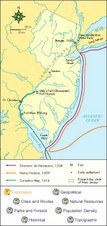After the British took over in 1664, English settlers who established the New Jersey colony encouraged African slavery so they could open up the land for agriculture and trade. Slavery was made legal under the government that was ruling at the time. In 1702 a governor from London was sent to New Jersey to "keep the settlers supplied with valuable Negroes at fair prices." These instructions became policy, and slave trade became an important part of the economy.
In 1774 the Provincial council rejected a proposed slave tax, and said that nothing would be allowed to interfere with importing slaves. By 1690 most people in colonial New Jersey owned one or more slaves. By 1738 New Jersey's slave population grew to about 4000.
From 1713 to 1768 the colony had a separate court for slave crimes. Slaves were forbidden any firearms. Also slaves could not assemble or be in the streets at night. The punishment for the slaves who commited crimes were much more severe, usually death. In 1735 a slave who tried to set a house on fire was burned at the stake.
Even free Africans were not treated fairly. Free Blacks in colonial New Jersey were not allowed to own land.
Tuesday, December 12, 2006
Government
The English were the first to occupy New Jersey. Phillip Carteret was the first governor and established Elizabethtown, the first settlement. It was run by a form of government called "Concessions." In this system, a governor, council and an assembly of twelve were chosen by the people. No taxes could be set without the consent of the assembly, and all Englishmen were given religious liberty. The first Assembly was mostly Puritan, and the laws were very strict. Within two years the people rebelled.
In 1676 New Jersey was divided into two parts. East Jersey was run by Carteret, and West Jersey went to the Quakers. Two completely separate governments were set up. In the eastern part there were many Puritans from New England who influenced the making of laws; there were thirteen crimes that had the penalty of death. In the West, a code of laws gave all of the power to the people.
When James II became King of England, he dissolved the governments and combined East and West Jersey, New York and New England under one government. When James II fell, the whole area was left in complete anarchy. Finally in 1702, New Jersey became a royal province of England.
List of Governers 1674-1699
Edmund Andros East and West New Jersey 1674-81;
Edward Byllynge West New Jersey 1680-87
Robert Barclay East New Jersey 1682-90
Daniel Coxe West New Jersey 1687-92
Andrew Hamilton East and West New Jersey 1692-98, 1699-1703
Jeremiah Basse East and West New Jersey 1698-99
In 1676 New Jersey was divided into two parts. East Jersey was run by Carteret, and West Jersey went to the Quakers. Two completely separate governments were set up. In the eastern part there were many Puritans from New England who influenced the making of laws; there were thirteen crimes that had the penalty of death. In the West, a code of laws gave all of the power to the people.
When James II became King of England, he dissolved the governments and combined East and West Jersey, New York and New England under one government. When James II fell, the whole area was left in complete anarchy. Finally in 1702, New Jersey became a royal province of England.
List of Governers 1674-1699
Edmund Andros East and West New Jersey 1674-81;
Edward Byllynge West New Jersey 1680-87
Robert Barclay East New Jersey 1682-90
Daniel Coxe West New Jersey 1687-92
Andrew Hamilton East and West New Jersey 1692-98, 1699-1703
Jeremiah Basse East and West New Jersey 1698-99
Clothing
During the colonial times in New Jersey the women wore aprons and dresses and the men wore pants, knee socks and fitted jackets. When kids were six years old they didn’t wear baby clothes any more. They wore the same clothes as the grown ups did. Most people did not have enough money to buy their own clothes, so they would make their own.
Religion
Because of all the immigrants, New Jersey had a lot of religious diversity. In East New Jersey there were migrants from New York and New England who were Congregationalists Presbyterians, and Dutch Reformers. West NewJersey had large groups of Anglicans and Quakers.
Because of their religious beleifs, the Quakers influenced the community in NewJersey. Quakers believed that all people were equal in God's eyes. They thought women should have an active role in their religion and gave them important leadership roles. As early as1688, Quakers had started to believe that African Americans should be treated equally.
Because of their religious beleifs, the Quakers influenced the community in NewJersey. Quakers believed that all people were equal in God's eyes. They thought women should have an active role in their religion and gave them important leadership roles. As early as1688, Quakers had started to believe that African Americans should be treated equally.
Monday, December 11, 2006
Education
The Middle Colonies were not really known for education. In New Jersey an effort was made to educate children, but schools were not as good as they were in New England. There was no public school system, so only families with resources could educate their children. Many children were forced to start working at a young age in order to generate an income for the family anyway. The education available was private academies, religious schools or private tutors.
A religious movement called the "Great Awakening" influenced education. It encouraged democracy in religion and the opportunity for everyone to be trained as a minister. Partly as a result of this, New Jersey's first college was founded in 1746. It was originally called the College of New Jersey and is now known as Princeton.
A religious movement called the "Great Awakening" influenced education. It encouraged democracy in religion and the opportunity for everyone to be trained as a minister. Partly as a result of this, New Jersey's first college was founded in 1746. It was originally called the College of New Jersey and is now known as Princeton.
Thursday, December 7, 2006
New Jersey Economy
In the 1760s the colonyof New Jersey had sixty towns. The largest city was Elizabeth. Most of the people who lived in New Jersey were farmers. They grew wheat, hay and barley. The Scots-Irish people farmed corn, both for people and for hogs. The rural farmers lived by the people in the city who bought their food.
Ethnicity played a role in New Jersey's agriculture. For example German farmers preffered using oxen rather than horses to pull their plows. By the 1750's the people had stopped using the tools that they had used in their own countries. Instead, the used a cradle scythe, that made it easier to harvest the grains. Farmers also increased their commercial production by fertilizing their fields with dung and lime and by rotating their crops to maintain the fertility of the soil.
But there was more to the colony than farming. In northern New Jersey miners dug for copper and iron. Because it had a coast line, New Jersey also had an active port. Workers loaded, sailed, and unloaded ships on the Atlantic ocean and the Delaware river. There was a booming export market because of corn and flour being shipped to the West Indies. The merchants who ran these export companies became wealthy and the port cities grew larger.
In the cities, skilled workers produced craftwork for the colonial people, which included glass, leather, and pottery. New Jersey began to show its wide range of different jobs and industries early which would later mark its future as a state.
Ethnicity played a role in New Jersey's agriculture. For example German farmers preffered using oxen rather than horses to pull their plows. By the 1750's the people had stopped using the tools that they had used in their own countries. Instead, the used a cradle scythe, that made it easier to harvest the grains. Farmers also increased their commercial production by fertilizing their fields with dung and lime and by rotating their crops to maintain the fertility of the soil.
But there was more to the colony than farming. In northern New Jersey miners dug for copper and iron. Because it had a coast line, New Jersey also had an active port. Workers loaded, sailed, and unloaded ships on the Atlantic ocean and the Delaware river. There was a booming export market because of corn and flour being shipped to the West Indies. The merchants who ran these export companies became wealthy and the port cities grew larger.
In the cities, skilled workers produced craftwork for the colonial people, which included glass, leather, and pottery. New Jersey began to show its wide range of different jobs and industries early which would later mark its future as a state.
Native Americans
When European explorers began arriving in the 1500s and 1600s, about 8,000 Native Americans lived in the region. They called themselves the Lenni-lenapes , which means "original people." Many Lenni-Lenape villages lay along the Delaware River , so the early European settlers called the people the Delaware.
The land provided everything the Native Americans needed. In the forests, Lenni-Lenape hunters killed deer, squirrels, foxes, raccoon, mink, and bears for meat and furs. Lenni-Lenape women planted beans, squash, and corn in the fertile soil. The Lenni-Lenape would pick wild cranberries, blueberries, and strawberries. In the spring, they traveled to the seashore, where they enjoyed the plentiful fish and shellfish. On their journeys, they created many trails that were later made into roads by European settlers.
The Lenni-Lenapes lived in villages of round wigwams, one for each family. The wigwams were made from saplings, cut and set into the ground to form a circle, with the tops tied together. Bark and grass covered the framework, and a hole at the top let smoke from the cooking fire escape. There were not many conflicts between the Native Americans of this area and the settlers, mostly because of the influence of the Quakers, who were pacifists.
The land provided everything the Native Americans needed. In the forests, Lenni-Lenape hunters killed deer, squirrels, foxes, raccoon, mink, and bears for meat and furs. Lenni-Lenape women planted beans, squash, and corn in the fertile soil. The Lenni-Lenape would pick wild cranberries, blueberries, and strawberries. In the spring, they traveled to the seashore, where they enjoyed the plentiful fish and shellfish. On their journeys, they created many trails that were later made into roads by European settlers.
The Lenni-Lenapes lived in villages of round wigwams, one for each family. The wigwams were made from saplings, cut and set into the ground to form a circle, with the tops tied together. Bark and grass covered the framework, and a hole at the top let smoke from the cooking fire escape. There were not many conflicts between the Native Americans of this area and the settlers, mostly because of the influence of the Quakers, who were pacifists.
Subscribe to:
Posts (Atom)

